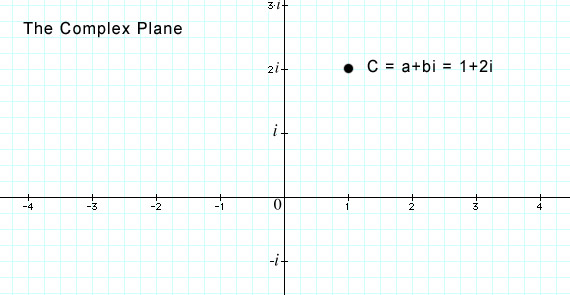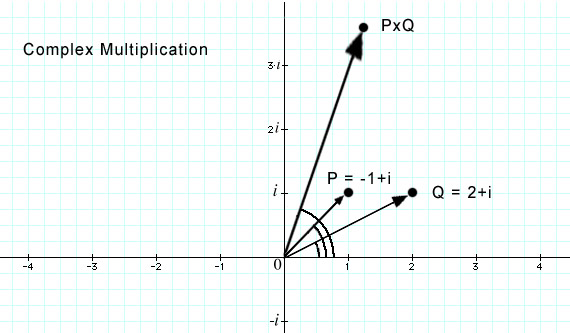From the Simple to the ComplexComplex NumbersIn the last section we iterated the simple equation Zn+1 = Zn2 + C , starting with the numbers
C=1, C=-0.5, and C=-1. We found that the fate of these starting points can be very different: The output of the equation can grow to
infinity, it can shrink to a fixed value, or it can alternate stably between two or more fixed values.  The Complex Plane, showing a point 'C' with a value 1 + 2i. Although they are not entirely 'real', it turns out that Complex Numbers are very useful in a wide variety of applications,
including, physics, engineering, and even art.
The Mandelbrot Set is made from the equation Zn+1 = Zn2 + C where Z and C are Complex Numbers.
In order to be able to compute this equation with Complex Numbers, we must be able to do simple arithmetic like addition and multiplication with them.
Fortunately, this turns out to be quite simple, and is illustrated below. Complex AdditionTo add two Complex Numbers, we simply add the Real components with the Real componenets and the Imaginary components with the Imaginary.
So for instance, if P = -1 + i and Q = 2 + i, then P + Q = 1 + 2i We can also look at these points in the Complex Plane as vectors, or arrows pointing from the origin to the point.
In this way of looking at Complex Numbers, we can add them by connecting the vectors in a parallelogram.  The new point P+Q can be found by adding the compnents of P and Q, or by connecting the vectors. Complex MultiplicationIt is also possible to multiply two points in the Complex Plane. It is much more convenient to multiply complex points in Polar Coordinates, where we define a point with an angle and a distance from the origin than it is to do the same operation in Cartesian Coordinates, where a point is defined as an (X-Y) pair. To multiply points in Polar Coordinates, we just add the angles of the two vectors, and we multiply their lengths.  Two complex points P and Q can be multiplied to form a new point and vector. When we calculate the Mandelbrot Set equation, we need to square the complex number Z. To do this, we're simply multiplying Z x Z, which by the rule given above just means
doubling the angle and squaring the length of vector.  Point B = [ ] Point C = [ ] Point D = [ ] Point E = [ ] What is the value of A+C? [ ] What is the value of C+D? [ ] What is the value of D+E? [ ] What is the value of E+B? [ ] Bonus Question: What is the value of (0+2i) squared? [ ] Now that you have seen the concept of iterating an equation, and understand the 2-Dimensional coordinate system we'll use, we can move into the next section. We'll see what happens when we iterate the equation Zn+1 = Zn2 + C and look at the fates of various starting values of the complex point C. |
|
<- PREVIOUS NEXT -> © Fractal Foundation. |